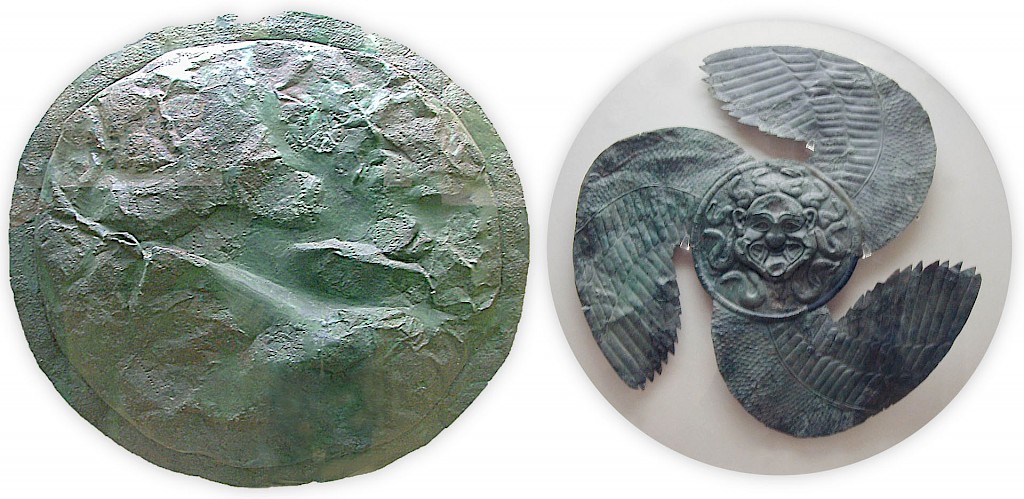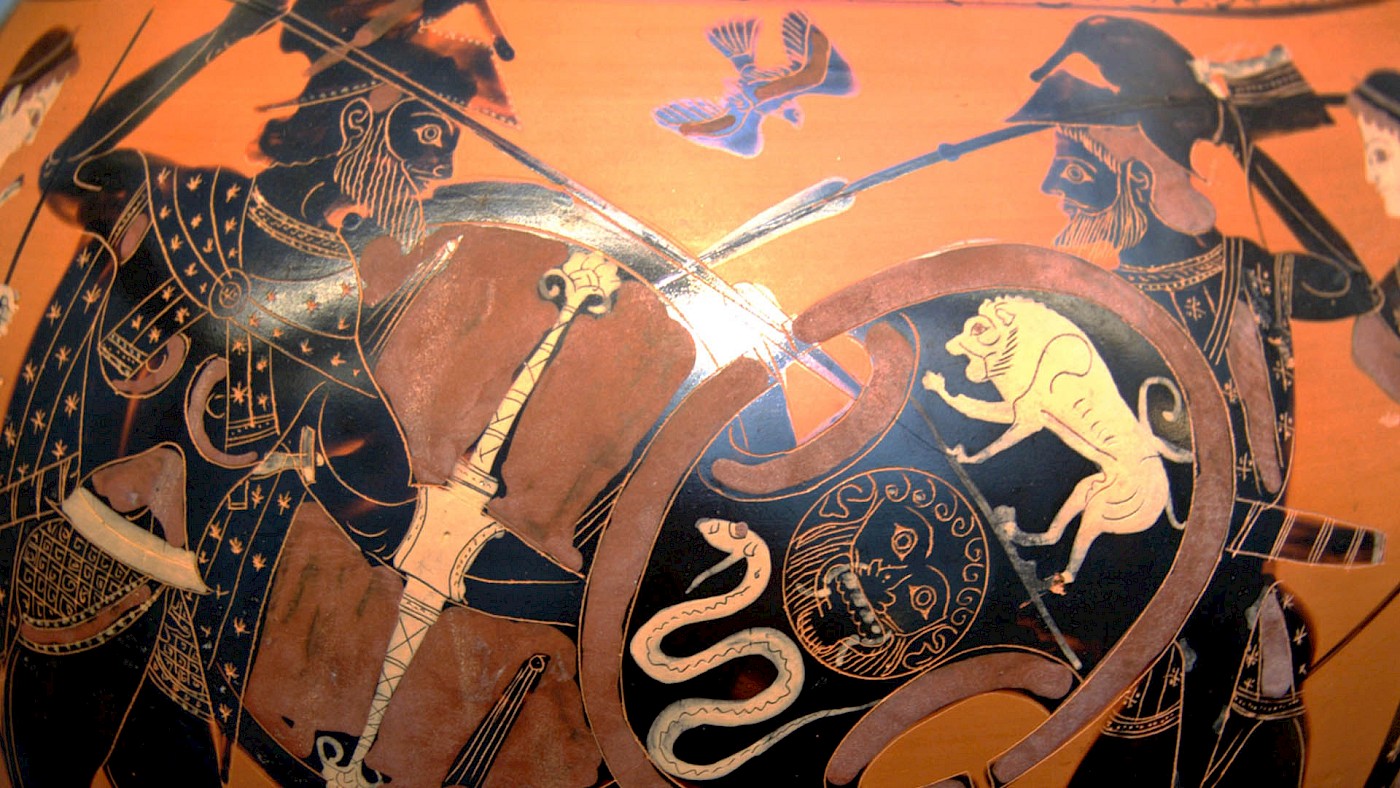Towards the end of the eighth century BC, the ancient Greeks invented a large, round shield (aspis) that was to dominate Greek warfare from that point onwards down the Hellenistic era. It’s often referred to as an “Argive” shield.
Structure
The Argive shield was round, about a metre or more in diameter. It was convex (“hollow”, as the ancient sources would have it), and featured a central arm grap (porpax) through which the left arm was put, while the hand grabbed a handle (antilabe) near the shield’s edge. Often, there was another antilabe on the opposite edge, which perhaps served as a spare. This shield type is associated with the ancient Greek hoplite, but it was emphatically not primarily known as a hoplon, nor did the hoplite derive his name from this shield.
There was at least one major variant of this type of shield. The scene from the black-figure vase that’s used as this article’s featured image, for example, features a so-called “Boeotian” shield: it’s similar to the Argive one, but often (not always!) oblong in shape and, characteristically, has two scallops cut from the side. Some modern commentators have argued that this type of shield never really existed, but I beg to differ.
The Argive shield was made from planks (presumably mostly oak). The rim was flat and generally reinforced with bronze. Sometimes, the entire outer surface was covered by a thin sheet of bronze. Some modern authors suggest the outside could also be protected by leather (such as ox hide), but there’s no ancient evidence for this (e.g. Everson 2004, p. 121). An Etruscan shield of this type, currently in the Museo Gregoriano (Vatican), still had traces of leather lining on the inside (Connolly 1998, p. 53). The porpax consisted of bronze and was used to reinforce the shield in the centre, where it was very thin.
Shield blazons
One characteristic of this new type of shield is that it often sported a blazon. Herodotus credited the Carians with inventing shield blazons, but this has generally been discarded by modern commentators.
Regardless of who invented shield blazons, they appear first on pottery of the late eighth century and are associated with round, likely Argive shields. Because of the double-grip construction, the shield is carried on the forearm in a particular way, allowing pictures to be painted on it with a clear up and down. (Obviously, if the warrior grabbed the second antilabe, as noted earlier, the picture would be upside down.)
Nevertheless, not all shields featured blazons: there are plenty of vase-paintings that leave the shield surface blank or painted a single colour. Other shields featured abstract patterns, such as spirals or a number of flat circles. But the most striking are shields that feature blazons in the shape of animals, monsters, or – more rarely – human figures. And while most of these blazons appear to have been painted on, we have examples of bronze blazons from e.g. the Panhellenic sanctuary at Olympia that were cut from sheets of bronze and featuring incised details.

Shield blazons were sometimes meant to terrify one’s opponents (at least symbolically). Such was perhaps the case with the Gorgoneion – the head and face of a Gorgon, a mythical creature with hideous features and snakes instead of hair, of which Medusa is the best known example.
In other instances, shield blazons were connected to the owner of the shield, and therefore must have had some personal significance. In some cases, the meaning might not be difficult to guess: a lion would symbolize strength and courage, for example, while a snake was a symbol of wisdom and immortality (because snakes sloughed off their skins at regular intervals, the ancient Greeks believed they continuously renewed themselves).
Of Sophanes, the son of Eutychides, bravest of the Athenian fighters at Plataea (480 BC), Herodotus wrote the following (Hdt. 9.74; transl. Purvis):
Two different stories are told about him: one, that from the belt of his breastplate he carried an iron anchor slung from a bronze chain, which he would throw whenever he drew near his enemies so that when they broke out of their position in the ranks to assault him, they would be unable to budge him; then, when his opponents were in flight, his tactic was to pick up the anchor and chase them with it. That is one of the stories; according to the other […], he did not actually wear an anchor attached to his breastplate, but instead had an anchor as an emblem on his shield, which never ceased moving and was always in swift motion.
Then, of course, there’s also our good friend Alcibiades (ca. 452-404 BC). His golden (!) shield supposedly sported the image of a thunderbolt-wielding Eros (Plut. Alcibiades 16.1-2). Eros was the son of Aphrodite, referred to in Latin as Cupid, and was normally armed with arrows. Alcibiades’ shield emblem was a less-than-subtle reference to his sexual prowess. As Hans van Wees points out, shield blazons were criticized by some in the fifth century BC as “betraying boastfulness and aggression, in contrast to the ‘modest’ undecorated shield of the wise man, and the simple white-painted shields of the common soldier” (Van Wees 2004, p. 54).

Nation-specific shield blazons don’t appear until quite late. The best-known of these are the Spartan lambdas or Λ, a reference to Laconia, the region dominated by the city of Sparta. However, these don’t appear to have been used prior to the Peloponnesian War (431-404 BC), around which time they are referenced by the Attic playwright Eupolis (of whose work only fragments remain). But the Spartans were far from typical: according to Xenophon, they were also noteworthy for having a uniform battle-dress, consisting of a red item of clothing (Xen. Spartan Constitution 11.3), most likely a tunic rather than a cloak (Van Wees 2004, p. 54 with further references). Other Greeks presented a far more diverse picture on the battlefield.
It’s not until perhaps the end of the fifth and the early fourth century BC that some Greek states started to sport national emblems on their own shields. The most famous of these are the Thebans, who decorated their shields with the club of Heracles. Apart from them, we hear of the people of Sikyon painting sigmas on their shields and the Mantineans using the trident. Not coincidentally, such symbols were also used on coins (Snodgrass 1999, p. 67).
However, for other cities, including Athens, we find little evidence for the widespread use of some kind of national symbol on shields. Some have tried to interpret the shield blazons as representing particular families, based mostly on shields depicted on Attic pottery, but these have mostly proven to be fruitless. Most likely, every warrior in most city-states simply picked a blazon that he felt best represented him.
Further reading
- Josho Brouwers, Henchmen of Ares: Warriors and Warfare in Early Greece (2013).
- Peter Connolly, Greece and Rome at War (1998 [1981]).
- Tim Everson, Warfare in Ancient Greece: Arms and Armour from the Heroes of Homer to Alexander the Great (2004).
- Anthony Snodgrass, Arms & Armor of the Greeks (1999 [1967]).
- Hans van Wees, Greek Warfare: Myths & Realities (2004).
